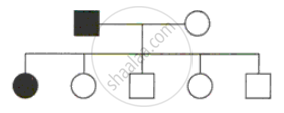Advertisements
Advertisements
Question
What is the scientific name of the pea plant that Mendel used for his experiments?
Solution
Pisum Sativum
APPEARS IN
RELATED QUESTIONS
Describe quantitative inheritance controlled by two pairs of genes.
A family consists of two parents and their five children and the pedigree chart below shows the inheritance of the trait colour blindness .

(i) Who is colour blind in parents - Father or Mother?
(ii) How many daughters and sons have beeen born in the family?
(iii) What does the child 1 indicate about this trait?
(iv) Complete the depiction of all probabilities of the trait among the children 2-5 in the chart.
(v) On which chromosome is the gene of this trait located?
(vi) Name one other trait in humans which follows the similar mode of inheritance.
Describe the cross between a homozygous tall, round-seeded pea plant and a dwarf, wrinkled-seeded pea plant. What will be the types of progeny in the F2 generation of this cross and in what proportion will it be?
Name and state the law which is explained by this example.
Multiple Choice Question
What is the effect of sexual reproduction?
Flowers of the garden pea are bisexual and self-pollinated. Therefore, it is difficult to perform a hybridization experiment by crossing a particular pistil with the specific pollen grains. How Mendel made it possible in his monohybrid and dihybrid crosses?
The inheritance pattern of a gene over generations among humans is studied by the pedigree analysis. Character studied in the pedigree analysis is equivalent to ______.
What does the progeny of a tall plant with round seeds and a short plant with wrinkled seeds look like?
In peas, tallness is dominant over dwarfness, and red colour of flowers is dominant over the white colour. When a tall plant bearing red flowers was pollinated with a dwarf plant bearing white flowers, the different phenotypic groups were obtained in the progeny in numbers mentioned against them:
Tall, Red = 138
Tall, White = 132
Dwarf, Red = 136
Dwarf, White = 128
Mention the genotypes of the two parents and of the four offspring types.
Enumerate the cause and the characteristic symptom of PKU.
